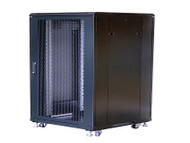How Should You Choose A Server Rack
Jan 11th 2020
How should you choose a Server Rack
Non-techies find it challenging to differentiate between server racks and typical racks. However, when you are planning to invest in server racks, it is essential to understand the distinct differences between the various data center racks. Read our Beginners Guide to Server Racks to get a synopsis on server racks and servers.
Open Frame VS Closed Frame
While looking for a rack, ask yourself first that whether you need an open or a closed frame rack (which is also known as a server cabinet.) The open frame racks are the racks that are open. They are available in both 2-post and 4-post options.
Open Frame Rack:
Advantages
- Cost-Effective- usually, the cost of the open frame racks are much lesser than that of closed frames.
- Air Flow- if maximum airflow is the primary method for cooling in your data center or server room then, open-framed, is the best choice as it gives constant access to the atmospheric air passing through your equipment.
- Accessibility- Open framed racks haveconvenient access to the equipment that is present inside.
Disadvantages
- Security- an open frame rack has a high risk of a security breach as all your equipment is exposed. Moreover, the buttons or wires can get tangled too or might even get unconsciously pulled or pushed while being cleaned.
- Dirt and dust- dust causes a hindrance to the high-heat flow and opposes the high-functioning operation of server equipment. An open-framed rack will rust in the presence of dirt and grime.
- Organization- if you value order and organization, the closed frame option might be a better fit for you as an open frame option will have everything out in public that includes cables, shelves, rails, etc.
Closed Frame Rack:
Advantages:
- Security- Closed frame racks are used to lock up the equipment, thereby protecting them from any unauthorized tamper, which thus reduces the chances of accidental device damage or use.
- Organization:- All organizations have a risk of someone accidentally tripping over the wires, pulling them over. It may lead to an accident. However, this offers the facility of storing the cables and other equipment inside the rack. As a result, the frame looks like a neatly arranged box.
- Airflow flexibility: Sensitive pieces of equipment may be isolated from the rest by placing them within the closest frame. The good news is that closed racks have specially designed cooling equipment and fans. So, we can control where the air flows from it.
Disadvantages:
- Cost– typically, closed frame racks cost more than that of open frame racks because for the additional parts or materials that are, used to build it.
- Accessibility– the process for fixing up or maintaining equipment is difficult due to the blocked nature of a closed frame rack. If you choose to use this type of boot, sliding rails and shelves for servers and other equipment is highly recommended.
- Weight– with the additional materials comes extra weight.
Size and Capacity
There is hardly any difference fundamentally, except that racks are open and cabinets come close. The key points of focus should be the dimensions and the volumewhen you are choosing your server racks. Server racks are typically measured in units categorized as "U" space. A "Rack Unit" or Rack "U" is an EIA standard allowance unit for measuring rack-mount equipment.
One "Rack Unit" is equal to 1.75" in height. The rack height is significant for how much material that can load inside, as well as how much power can be transmitted to equipment in the server storage device.
Group manager Mike Kendall, of options and infrastructure for industry-standard servers and software at Hewlett-Packard, told the news source the 19″ rack is widely considered a standard size for equipment storage. There are various types of frames available in the market, but the most frequent type you see in data centers is the 42U-high 600mm-wide rack, which is anywhere from 1,000 to 1,100 mm deep. These all support mounting of standard 19" IT products. Another frequent type of frame you'll find in a data center is a 36U rack, but the data centers widely use 42U-high, according to Mike Kendall, which was told to a Data Center Journal.
However, when you need to store equipment at more significant heights, much of the companies station bigger server racks than that of a 19" frame with a 42U height, which is commonly used.
There are instances where smaller racks are advantageous for the organizations that have space issues between the server rack and the roof. Sales of server racks can be humongous as most of the companies are venturing into building data center facilities. With the survey conducted by RealPoints, revenues are generating more from IT systems that are censorious, bringing in more funding for the data centers that are outsourcing services for everything fromcolocation to disaster recovery.
Investor or an owner can cash in more fortune by using taller racks as it accredits to smaller data center area being used.

